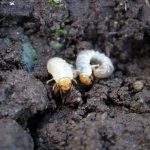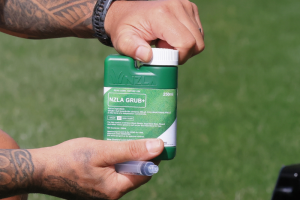Is it too late to apply Grub+ for grass grub in New Zealand?
Many people think that if you miss September or October, the grub season is over and applying Grub+ later won’t do anything. That idea pops up every year, but it doesn’t line up with how grass grubs actually behave in New Zealand.
Grass grub adults, which are the beetles you see flying around lights in spring, start emerging from the soil around November. They only live for a few weeks and spend that time mating and laying eggs across your lawn. Those eggs hatch roughly two weeks later, and the first instar larvae begin feeding on the lawn’s roots straight away.
As the weather warms up, the grubs move closer to the soil surface and cause most of their damage through summer. They feed heavily through December, January, February and into early autumn. By around March they’ve usually caused the damage you’ll see before burrowing down for winter. Over winter they sit deeper in the soil, pupate, and then reappear the following season as adult beetles. The cycle then begins again.

The reason we recommend applying Grub+ in late September or early October is because it positions the product in the soil before the eggs hatch. That gives the strongest protection when the larvae are young and easiest to control. But this is the ideal timing, not the only timing.
Egg hatching in New Zealand doesn’t all occur at once. Depending on region and climate, hatching can continue into December and even early January. The larvae remain active and feeding right through to March. This is why many lawn and garden guides in New Zealand note that treatments through summer can still be effective. Earlier is always better, but applying Grub+ in December, January or February still helps prevent further feeding damage and still offers protection for the rest of the season. Grub+ also remains active in the soil profile for 6 months, this is the only product in New Zealand that doesn’t need repeat applications for proper control.
If spring got busy and you missed your planned application, you haven’t missed the boat. Grubs are active from November through March, and they’re vulnerable during that entire feeding period. The only time it becomes too late is once they’ve gone deep for winter and you can no longer reach them.
So to answer the question: no, it’s not too late to apply Grub+. If you want to protect your lawn from grass grub damage throughout summer, applying now will still make a meaningful difference.
Frequently Asked Questions About Grub+ Timing:
When is the best time to apply Grub+?
Late September to early October is the ideal window, because it protects your lawn before the eggs hatch and the grubs begin feeding.
Can I still apply Grub+ in summer?
Yes. Summer applications are still effective and will still reduce feeding damage.
How long do grass grubs stay active?
Grass grub larvae remain active near the soil surface from November until around March.
What happens if I don’t treat them?
Untreated grubs continue feeding on your lawn’s roots through summer, causing thinning, browning and bare patches that can’t be reversed once the damage is done.
Where can I purchase Grub+?
Grub+ is available from the New Zealand Lawn Addicts online shop.
Want to learn more about the life cycle of Grass Grubs? See our article Controlling grubs in your lawn.

Comments
0